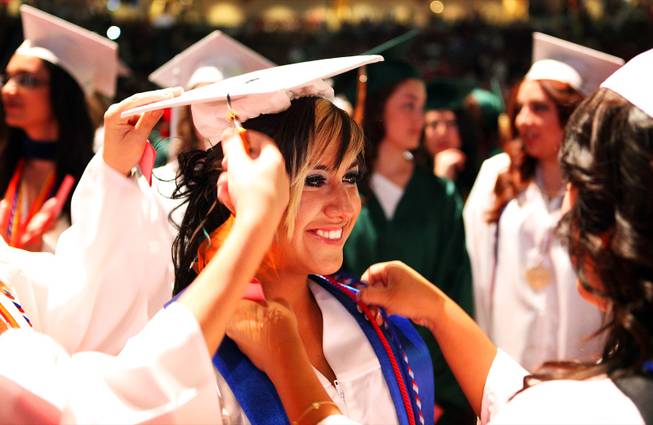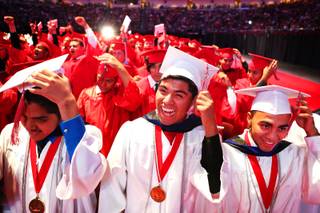
Jazmin Rodriguez-Davila gets some help from friends with her tassle and robes during the Mojave High School commencement ceremony at the Orleans Arena on Friday, June 15, 2012.
Sunday, June 24, 2012 | 2 a.m.
Sun coverage
This is another in a yearlong series of stories tracking Clark County School District's efforts to turn around five failing schools.
As the Clark County School District celebrated the graduation of more than 15,000 seniors this month, there were few ceremonies more poignant and symbolic than those for the three “turnaround” high schools.
With the turning of hundreds of colorful tassels, high schools Chaparral, Mojave and Western concluded their first year of a multiyear “turnaround” that seeks to improve the lot of thousands of children attending Las Vegas’ worst-performing high schools.
To receive $8.7 million in federal funding over three years, these “turnaround” high schools – among the bottom 5 percent of schools – took a chance on some drastic measures.
Principals and teachers were replaced. Schools were cleared of graffiti and trash. Schedules were altered and the school day was extended. Consultants were brought in to help teachers reach at-risk youths. New curricula and a renewed sense of focus on students and their performance prevailed on campuses.
At the end of the year, these changes have helped graduate more seniors and kept more students on track to exit high school ready for college or work, officials said. Test scores, especially in math, have steadily improved. Incidents of violence and vandalism have plummeted. Students are slowly returning to campuses, seemingly buoyed by the transformation.
Despite the improvements, these “turnaround” schools still have a long way to go, officials contend. Test scores are still too low and the number of dropouts is still too high, they said. Districtwide, more than 8,000 students who began as freshmen in the class of 2012 failed to graduate after four years of high school.
The turnaround will take time, but the first-year gains showed promise and potential, officials said.
“We still have a long way to go,” Clark County Schools Superintendent Dwight Jones said. “It’s hard work to turn around these schools. But all these schools are better than when we started. I’m optimistic they’re on the right track.”
Earlier this month, thousands of families gathered at the Orleans Arena to witness their children’s significant milestone into adulthood. Amid the “Pomp and Circumstance” and colorful caps and gowns, there were laughter and cheer, hugs and kisses and tears streaming down smiling faces.
Graduation also gave principals and teachers, students and parents a chance to reflect on the first year of the “turnaround.” Here are their voices:
Chaparral High School
Chaparral’s senior class president Desiree Galvez said the School District’s decision to replace principals and staff came as a surprise – especially to the Class of 2012, whose members were juniors when the “turnaround” was announced. Hundreds of students had protested the announcement in spring 2011 with a rally by the school’s flagpole.
“Just when we were supposed to have everything figured out, everything changed,” Galvez said. “But we did what Chaparral students did best: We adjusted.”
The changes almost caused Chaparral senior Corby Easton to transfer to another school.
“I didn’t like losing the teachers, and everybody loved our (former) principal,” Easton, 18, said. “I’m glad I stayed, though. I ended up liking it a lot. I think it’s only going to get better.”
Chaparral Principal Dave Wilson applauded Galvez, Easton and their classmates for adapting to the changes, which included working and clean toilets, Wilson said. The academic, cultural and social changes at Chaparral took courage on the part of students, he added.
“You know what it’s like to transform. … I’m excited to see how you’ll change the world,” he said, addressing the graduates.
Although final figures have not been released, Chaparral’s graduation rate is expected to jump from 33 percent last year to 54 percent this year, Wilson said.
Wilson never thought Chaparral would be able to graduate 100 more seniors in one year.
“I’m proud of our kids, our teachers and our parents,” he said. “This year was a huge success, all due to great people doing great things.”
Spanish teacher Lynne Eichenfield said the turnaround work had been challenging but the positive changes were rewarding. While she lamented the loss of “some good teachers” as a result of the turnaround, Eichenfield said Chaparral gained some good, new teachers and administrators who restored a sense of order and discipline to the school.
“This year, I’ve seen kids in class where they belong,” the 14-year veteran teacher at Chaparral said. “There was a focus on studying and an insistence on kids being in the classroom.”
Adria Dixon, mother to Chaparral senior Christopher Streeter, said the “turnaround” efforts at Chaparral helped her 18-year-old son graduate this year. Dixon’s husband and Streeter’s stepfather agreed.
“I think it was a great improvement,” Vern Dixon said. “There had to be a little more discipline and structure in the school.”
Mojave High School
Addressing the sea of green caps and gowns, Mojave High School Principal Antonio Rael said he was just as “fired up” about his Rattlers on the last day of school as he was on the first.
Many of the graduating seniors at Mojave were the first in their families to earn a high school diploma, Rael said. As a first-generation high school graduate, Rael said he hoped his personal story of overcoming an impoverished background would resonate with his students, the majority of whom are from low-income and minority families.
“Success! Nothing less!” Rael told his students, invoking the oft-heard mantra at Mojave. “I encourage you to keep living by that motto.”
The North Las Vegas high school that had been plagued by regular fights and vandalism saw a 50 percent decline in discipline issues, Rael said, attributing the decrease to a cleaner campus, an engaging staff and a Saturday school to discipline students.
Even at graduation, that new sense of order seemed to surprise longtime Mojave math teacher Deb Brown.
As the graduates stood up during the Pledge of Allegiance and the singing of the national anthem, all the boys removed their green graduation caps at the behest of a student.
“That was the neatest thing,” Brown said. “That’s cool.”
Generally, students had better focus on schoolwork, as evidenced by a record student turnout in Mojave’s afterschool and Saturday tutoring sessions, Brown said.
“Kids were really encouraged to take advantage of every opportunity to make up credits,” Brown said. “Some of these kids may not have been here (at graduation) today because they didn’t have those credits.”
The “turnaround” wasn’t easy, but it’s made a difference at Mojave, said assistant principal Lisa DenBleyker. In her 18 years with the School District, DenBleyker said she’d never worked so hard to begin turning around a low-performing school.
“We’re still figuring it out, but when our kids saw us stepping up, they responded,” DenBleyker said. “We have a good grip on who the high-need kids are, so we can hit the ground running next year.”
The turnaround turned out great, said Virginia Mendoza, mother of Jessica Serrato, 19, newly graduated from Mojave.
“At first we weren’t so sure what’s going to happen, but it looks like it turned out good,” she said. “It’s a better school now. The principal made a huge different in school spirit. He brought a new attitude, to be more involved and motivated to want to be in school.”
Serrato said the changes brought about by the “turnaround” were tough to swallow at first. Stricter dress codes, penalties for tardiness, Saturday school and twice-weekly counseling sessions were just “different,” she said.
“At first, we weren’t happy about it. We were used to our ways,” Serrato said. “It was a drastic change.”
But with the help of her teachers, test-prep sessions and online credit-retrieval courses, Serrato said she was able to pass her math proficiency exam and make up enough credits to graduate.
“I’m really, really happy I went to Mojave,” said Serrato, who plans to become an ultrasound technician. “People say Mojave this, Mojave that, but they see we’re a turnaround school now. I’m so proud of Mojave.”
Mendoza said she appreciated Mojave’s efforts to help her daughter graduate and is glad Serrato’s 14-year-old sister will be attending the school as a freshman in the fall. While Mojave typically lost dozens of students each year due to transfers and dropouts, student enrollment is now expected to rise next school year, Rael said.
“We’re happy about that,” Mendoza said.
Western High School
When English teacher Jennifer Wood stepped on the Western High School campus for the first time last spring, the “turnaround” had just been announced at the central valley school.
Forced to replace at least half of the staff, Western had just begun the reapplication process for its teachers. No one knew if they would be able to return next school year.
“It was a bad time,” Wood said. But in the end, the turnaround turned out to be a good experience, she said.
Western’s new focus on science and an extended school day have helped students connect coursework with medical careers, slowly returning academic success to the once high-performing school. Not only did Western’s graduation rate increase this year, but also 83 percent of its freshman class – the school’s first “turnaround” class – is on track to graduate, said Principal Neddy Alvarez.
“It was a fabulous year,” Alvarez said. “The turnaround helped a lot. It’s been the best thing for Western.”
Fawn Buzzard, whose 18-year-old son Daniel graduated Wednesday, said the “turnaround” was a welcome change to her alma mater.
“It’s amazing how many more kids were able to graduate,” Buzzard, class of 1984, said. “It worked.”
Other parents weren’t quite as convinced about the effects of the “turnaround.”
“We just finished the first year,” said Shirley Bagain, whose 17-year-old daughter Christina graduated Wednesday. “Let’s see how it all works out after three years.”
Mary Lynn Riggs, who has multiple children at Western, said it’s hard to tell if the “turnaround” was worth it. Western lost many good teachers during the transition, she said.
However, the new teachers are “fantastic,” and her son, a freshman, enjoyed the new medical courses, Riggs added.
Western senior Lizzy Riggs, 17, said the “turnaround” was a good start to return Western to its former glory. However, the class salutatorian said she was concerned Western focused too much on academics as a result of the “turnaround” and less on extracurricular activities that make school fun for students.
“Academics obviously needs to be first, but we need good athletics and clubs,” she said, lamenting budget cuts to Western’s theater. “Once we get the academics down, everything else hopefully falls into place.”
Lizzy’s 22-year-old sister, Mary Riggs, said she’s happy with the changes at her alma mater. The class of 2012 seemed to be more studious than her class of 2007, which was more interested in “socializing,” Mary Riggs said.
“Western’s a good school now that they’re focusing on academics,” she said. “There’s been a big change with this “turnaround” but it seems like they’re going in the right direction.”



Join the Discussion:
Check this out for a full explanation of our conversion to the LiveFyre commenting system and instructions on how to sign up for an account.
Full comments policy